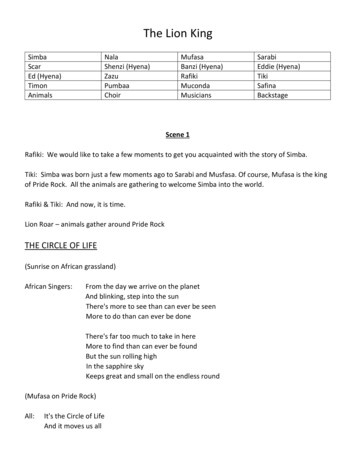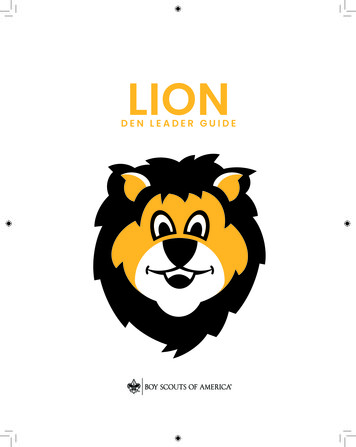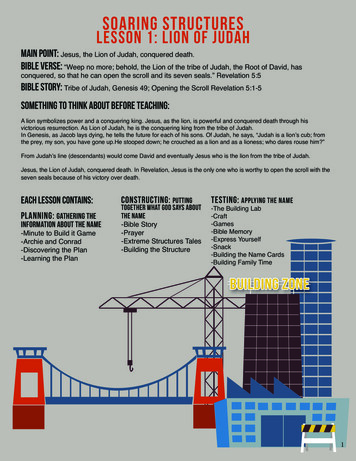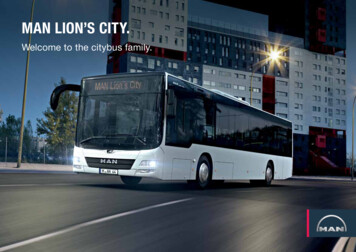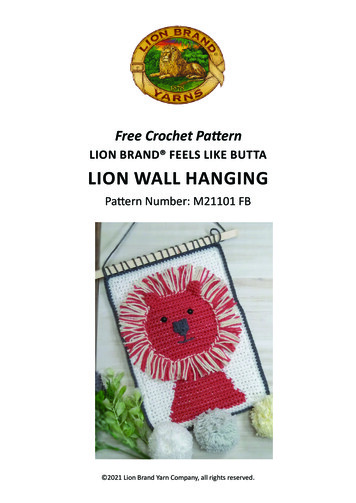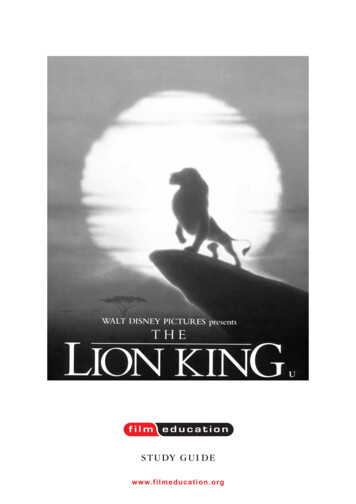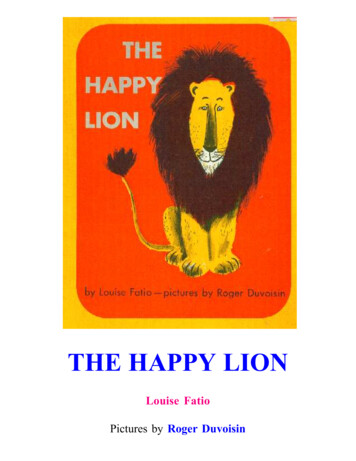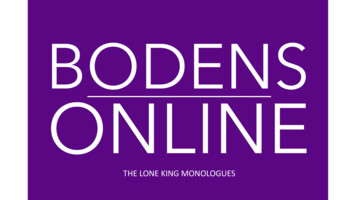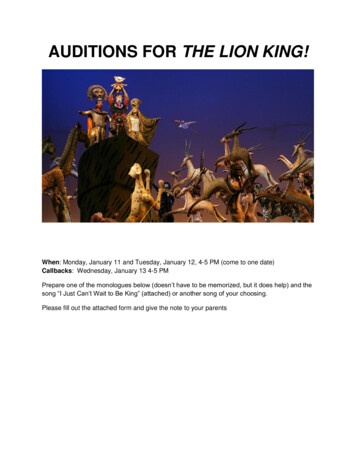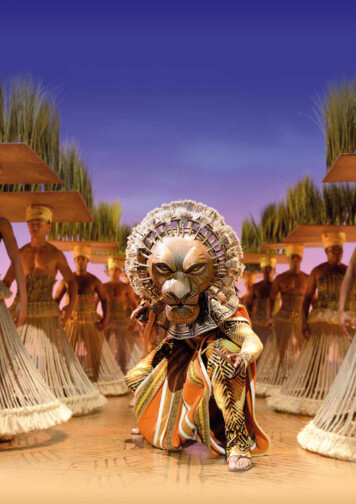
Transcription
Production NotesVenue: The Lyceum Theatre, London (also playing at theMinskoff Theatre on Broadway in New York City,and many other venues around the world)Director/Costume Designer/Mask & Puppet Co-Designer: Julie TaymorChoreographer:Garth FaganScenic Designer:Richard HudsonLighting Designer:Donald HolderMask & Puppet Co-Designer: Michael CurryHair & Make-up Designer:Michael WardSound Designer:Steve Canyon KennedyAssociate Director:John StefaniukAssociate Choreographer:Marey GriffithYour exclusive guide to the design considerations, costumes, and puppets as well astop tips for writing about the West End stage show. This resource will be of particularuse to students studying drama, theatre and performance.You may also find it useful to refer to the ten Behind-the-Scenes episodes and theGetting Ready to Roar film resources that reveals the action backstage at theLyceum Theatre, freely available at lionkingeducation.co.uk Disney
Design Considerationsthe mask and how to make them clear to theaudience, which may be some distance away. hat are the challenges of using masksWand costumes in The Lion King? There are no real animals in this show: theperformers need to communicate the essenceof each animal, without trying to imitate them.The ensemble needs to be able to quickly switchbetween animal characters and other naturalelements. Julie Taymor was inspired by African and Asianart and culture, this can be seen in the patterns onmany of the costumes (see the Lionesses on oppositepage). Masks have a static expression, so the characterneeds to be animated by the actor’s face. In The Lion King, the actors speak and singthroughout the performance, which was aconsideration of the utmost importance whendesigning the masks. Additionally, Taymor utiliseswhat she calls the “double event” which allowsthe audience to encounter both the animal traits ofthe design and the human emotions of the actorsimultaneously, creating a singular, whole character.By not obstructing the actors’ faces with masks orpuppets, Taymor achieves both of these goals. The designer of the mask has to decide whichcharacteristics need to be communicated through Lighting, costume design, choreography anddirection also need to take into account theweight and shape of the mask. The masks aremade of very lightweight material and they areused by performers in rehearsal to develop theircharacterisation, so that they become an extensionof the performer’s own body. The Lion King is a non-naturalistic musical.Therefore, the performance style of the productiondoes not rely on a ‘life-like’ representation ofeveryday life. A high level of technical expertise is required by thecompany as there are so many different elements tothe production, including large scale set pieces suchas the Elephant Graveyard, and busy ensemblenumbers involving numerous puppets and setpieces. All of this requires strict attention to healthand safety guidelines. It can be difficult to create the sense of scale andthe quantity of animals required to depict the naturalenvironment of the show. Taymor often solves thisby what she calls “corporate puppetry”, where oneperformer wears or operates a number of puppetsat the same time to multiply the number of thoseanimals on stage.Design fundamentals – what do you notice?The dominant idea is the Circle of Life. Throughout the production design, there are circles present.This includes the design of Pride Rock which spirals up from the stage. Where else can you see circles in the show?The sun in The Lion King is constructed from43 aluminium ribs attached to each other with silkstrips. As the circle is lifted up by the wires, it gives theimpression of the sun coming up over the horizon.There are more than 232 puppets in the show, includingrod puppets, shadow puppets and full-sized puppets.It took 37,000 hours to build the puppets and masks.The longest animal is the elephant: 4 metres long,3.5 metres high and 2.75 metres wide.34
NalaSimbaThe role of Simba is played by two actorsand the character is also represented byvarious puppets throughout the show.YOUNG SIMBA wears the same make-up aroundhis neck and chest as adult Simba, which is basedon ceremonial Maasai warrior make-up. YoungSimba does not wear a mask or wrist cuffs as theadult Simba does. He needs to retain the childishfeatures of a young lion and be able to roll,jump, leap and climb. When the adult wears theadditional items, the costume suggests his increasedmaturity and strength.ADULT SIMBA wears a beaded corset whichis inspired by the clothing of Maasai warriors.The top of the corset sits just beneath the chest,which helps the shoulders seem even broader andstronger – this is where much of lions’ strengthcomes from when hunting.Part of Simba’s transition to being an adult is theaddition of a headpiece. It is different to that wornby Mufasa – the design is based on the idea ofa Roman warrior helmet. Like this kind of helmet,there is no jaw line, which suggests that Simba isstill only a young adult. His mane creates the brushthat was worn on Roman helmets, and presents himas a brave fighter. This helps emphasise the idea ofSimba fighting bravely for what is right followingthe death of his father.CONSIDER.During Hakuna Matata, Simba appears to grow upwithin eight seconds – watch closely at the transition,use of space and staging to achieve the sense oftime passing. How does the set also play a role inthe transition?NALA is played by a child and then an adultactor. Nala’s costume contains elements of bothAfrican and Asian culture to illustrate the manyaspects of her character.Both Young Nala and adult Nala wear thesame style and design of corset throughout theperformance. The white beads in the centre ofthe corset emulate the soft white underbelly thatis typical of lions and lionesses. The harp-likeshape at the back of the corset is based on thecorsets worn by Dinka people from Sudan.Her collar and movements come from Bali whichadd grace and fluidity to her characteristics.Nala’s make-up is inspired by the Wodaabepeople – a tribe known for their beautifuland elaborate appearance. Young Nala’smake-up is less detailed and intricate thanthe adult Nala’s.Similarly to the Simba character, Nala’s mask isonly worn by the adult performer. Like Simba’s,the mask is jawless, does not move and sits onthe head like a crown, emphasising youth ratherthan experience.CONSIDER.The role of Nala in the stage production; whatare the moments that define her character andwhat words would you use to describe her keycharacteristics?56
MufasaScarMUFASA’s character represents wisdom, balanceand strength: the design of his costume and maskreflect this.His mask is circular and symmetrical with rayscoming out of it like the sun, which implies that heis balanced and in harmony with nature. His maskis painted to look like rich oak wood to convey hisqualities of strength and reliability. This circularshape also represents the Circle of Life, a centralmotif of the show.Much of the character’s costume is inspired bytraditional Maasai dress, specifically his braidedhair, red make-up, Maasai swords and corset.The red make-up also forms a connection betweenMufasa and Simba, his son. His swords areoccasionally used to represent his two front legs inmoments of heightened tension, when the character’sanimal instincts become more pronounced.The fabric that connects the nape of the actor’sneck to the front of his waist is based on traditionalKuba cloth and helps his movement appear fluid.This feature echoes the costumes of the lionesses,indicating that Mufasa fits in well with the othermembers of his pride.Mufasa’s costume contains golden and orangetones that suggest sunlight, re-enforcing his regalposition and depicting him as a force for good.SCAR is a manipulative and sinister character. Scar’sheadpiece does not include the same circular form asMufasa’s. Instead, it is distinctly asymmetrical, givingthe impression that he is imbalanced and skewed. Themask has high cheekbones and a sharp, spikey manethat sits only on the very top of the mask, rather thansurrounding it. The green eyes suggest malevolence incomparison to the wooden eyes of Mufasa’s mask andhis eyebrows are arched in such a way to make himappear cynical and cruel. Both Scar and Mufasa’smasks are attached via a head mount whichenables them to be worn in front of the face, or asa headpiece.Scar carries a single cane. When standing upright,he uses the cane to support himself (as opposed toRafiki who uses her staff to give emphasis to actions).When Scar becomes more combative, he leansforward onto the cane, as if it’s a lone front leg.This suggests that he may have lost his other leg inthe same fight that scarred his face.The silhouette of his costume is based on that of atraditional Japanese samurai. This reflects his nobilitybut also presents him as a ruthless warrior. Theouter layer is made of bamboo which depict bonesand ridges and show Scar to be a frail and skeletalcharacter. The layer of fabric underneath the bamboohas a Kuba cloth pattern which places the characterin Africa and connects him to the other lions in theproduction.Scar wears wide ‘chaps’ which make his hauncheslook angular and bony. His movements are volatileand unpredictable in contrast to Mufasa’s movementswhich are strong and fluid. He wears boots (dyed tomatch the colour of the full-length trousers) whereasMufasa wears traditional brown leather sandals:his is a natural strength – Scar needs help tobe strong.CONSIDER.The characters of Mufasa and Scar are brothers.They are both adult lions, but their appearanceis vital in communicating their very differentcharacters. The make-up, mask and costume,combined with the actors’ body language andstylised movement create the characters’ personalities.RESEARCH TASKLook into the clothing of traditional Japanese samuraiwarriors. What similarities do you notice betweenthem and Scar’s costume? How does the structure andsilhouette of his costume suggest that although he is ofnoble birth, he is weak?78
Timon and PumbaaRafikiCONSIDER.The design of Rafiki’s baobab tree; what is its function inthe story and what practical considerations have beenmade when designing this set piece? See pages 15 and16 for a visual reference.The casting and costume help to create the comedydouble act between Timon and Pumbaa. Think of manyfamous duos and you’ll see that their size and shapesare often opposites of each other. Timon and Pumbaaare no exception.The actor wears a large, bristly wig, with vertical hairlike a Mohawk, to create the hair of the warthog’sback. His face and neck are covered in purple andwhite make-up which recalls the brown of the warthog’sskin and the white of his tusks.This character represents a Sangoma healer fromsouthern Africa. Rafiki’s role in the story is that ofa narrator. At certain moments, she addresses theaudience directly. She is the only one who breaks thefourth wall.TIMON is a meerkat. The actor’s own costume (agreen all-in-one suit, a green wig and green make-upon his entire face and neck) is designed to blend into the jungle scenery of many of Timon’s scenes. Thisis a bunraku-inspired puppet. The intention is that theaudience will experience the “double event” so thatthe character is fully formed by both the puppet andthe actor.Behind the actor, the puppet is formed by a structurelike a ribcage. The actor’s legs form the front legsof the warthog and there is no attempt to hide theactor’s body.RAFIKI is unusual in that she does not wear a maskand does not operate any kind of puppet. Her animalpersona is created through costume and make-up.Timon is attached to the actor in three ways: i) bytransparent wires connecting Timon’s head to the actor’sown (the actor uses a hand to control the puppet’smouth), ii) the actor uses rods to control the puppet’sarms, iii) Timon’s feet are attached to the feet of theactor’s costume, and so ‘walk’ in the same way thatthe actor does.PUMBAA is a warthog, and is larger than Timon.His belly is very close the ground, and his characteris welcoming, warm-hearted and comical. The bodypuppet is worn in front of and behind the actor whouses his own arms to operate the mouth of the puppet.He can also operate the large tongue with his arms. Theears of the puppet are attached to the actor’s shoulders.9Sketch ofPumbaa bodypuppet withactor in situ.Sketch ofthe Timonpuppet.CONSIDER.How does the design of these two puppets differ from the restof the production, what does this tell the audience about theirrole in the story?The creative team were inspired by the mandrill monkeywhen designing Rafiki.For her make-up, blue, yellow and red are used toaccentuate the facial features. Arched blocks of yellowsurround each eye which create width. Blue makeup sweeps from cheekbone to jawline and drawsour attention towards the mouth, with white make-upapplied (using a fan brush) to reference a mandrill’sfacial features.Rafiki’s make-up also includes an earthy red colourwhich surrounds the mouth – this highlights thewhiteness of the performer’s teeth.Hair: A wig gives the appearance of spiked hair torepresent the mandrill’s thick fur. The edge of her hatis made from Kuba cloth.rings around them, which connect the character’shands to her sleeves, further elongating her arms.Feet: Her shoes are sculpted to look like a mandrill’sfeet standing on a rock.Rafiki wears a collar piece which includes red, yellow,blue and white, mimicking her facial make-up.The collar is finished with black feathers which createan effect of thick fur.The back of Rafiki’s costume is padded to accentuateher behind: mandrills have large pads called ischialcallosities that provide padding – Rafiki’s costume notonly presents anatomical accuracy but also createscomedy as parts of her costume sway slightly whenshe walks.Rafiki’s skirt matches the colour of her hat, and the lightbrown echoes the earthy and wooden materials thatmake up the rest of her costume.Because Rafiki represents a healer, you will see anumber of different ‘medicinal’ items on her costumeincluding bottles and shells. She also walks using a staff– this suggests age and perhaps wisdom. The performeruses it to emphasise what she says and gesticulates.The timing of this often creates comedy.Hands: Bamboo tubes are worn on each finger – thismakes her arms look longer. Her forearms have rope10
ZazuThe LionessesHyenas (Banzai, Shenzi and Ed)Unlike most of the other animals, the key colour ofthe HYENA’s costume is grey/green. The actors’all-in-one boiler suit costumes also have black patcheswhich appear to be tearing off. This is an effectiveway of signifying to the audience that the hyenas arescavengers and covered in scars.This costume relies strongly on the physicality andmovement of the actor wearing the costume.His/her head naturally creates the hyena’s hump,by being higher than the face of the hyena, whichis attached to the actor’s chest by a bungee cord.The head of the hyena is also attached to the actor’shead by transparent strings so that they can controlits movements. A strip of black spiky ‘hair’ connectsthe hyena head to the hood of the actor’s costume,mimicking the fur along a hyena’s spine.they are fairly stationary), the actor can slip one armfrom the crutches and operate the mouth of the hyenahead instead.CONSIDER.Why do you think the hyenas wear military style boots?Throughout the production, watch the hyenas carefully.When moving, the actor uses short crutches on theirarms to represent the front legs of the hyena.During moments of dialogue (and therefore whenSketch of the actor’scostume elementsZAZU is represented by two elements – the humanactor who plays the character, and the puppet thatrepresents the character. Both elements are clearlyvisible to the audience. This is another example ofthe “double event”.The design and pattern of this costume represent thefusion of the African setting with the Englishness ofthe character. The actor’s costume is based on anEnglish butler’s uniform with tails which, along withhis feathery cravat and bolwer hat, show that he isa butler and the king’s majordomo. The costumeis made of African Kente cloth, which ties into theAfrican origins of the story; it is also blue from headto toe which represents the character’s naturalhabitat – the sky.The puppet is one of the most complex puppets inthe production and is operated, for the most part,using both hands. One hand controls the neck andhead of the puppet, the other controls the rest of itsbody including the wings. The beak moves for thedialogue and the actor can also make the eyelidsblink, creating the sense of a mannerism when Zazuis particularly frustrated. The wings can also extendfrom the body and flap, creating a flying motion.11Even though you may not be able to see it in detailfrom the auditorium, each of the corsets worn bythe LIONESSES is unique and individual to eachactor. Although the patterns on their costumes vary,the headpieces are the same overall shape, creatinga strong sense of tribe (the pride). The headpieces arereminiscent of the urns carried on the heads of womenin various African tribes. Some of their masks includestrips of translucent organza which are revealed as tearswhen the pride are mourning the death of Mufasa.Notice how long pieces of silk flow down the back of thelionesses, from the base of the headpiece to their knees,creating a smooth and elegant profile. The costumecreates a sense of majesty and elegance as the lionessesleap and dance.DID YOU KNOW?There are 22 corsets worn in the show, each is individuallyhand-beaded and contains several thousand beads. Thereis no inclusion of glittery or sequinned beads in the corsets.Instead, the beads are all a matt colour to depict the sunbaked heat of the savannah.12
Creating the animalsIn the opening sequence of the performance the creative team fill the stage withhuge numbers of animals of the Savannah.Giraffe: Two actors enter stage left. Each actor is on 4 stilts and wearing a tall headpiece whichforms the neck and head of the animal. This leaves the actors’ faces clear to be able to sing.Cheetah: This puppet is worn around the waist, the back legs sit parallel with that of the actor.The head, body and front legs of the cheetah sit ahead of the actor and the front legs are operatedby poles held by the actor.13Zebra: The actor appears in the centre of the zebra, the puppet is worn via a harness that restson the actor’s shoulders. The actor’s legs appear as the zebra’s front legs, the zebra’s back legs areoperated by poles held by the actor.Gazelles: A good example of “corporate puppetry”, each actor wears a lightweight gazellepuppet on each arm and also one on their head, attached via a head crank. There is also a gazellewheel. The dancer pushes this rig across the stage and the wheels turn, causing the gazelles to leapacross the landscape.14
Set DesignWhat are the challenges of designing a set for The Lion King? T he Lion King is the story of a young lion’s journeyfrom childhood to adulthood, set in the vast landscapeof the African savannah. There are a variety of differentlocations, including Pride Rock, the grasslands,the Elephant Graveyard, the jungle, the gorge where thestampede occurs and the waterhole. In the film, animatorscould create multiple landscapes and environments,but in live theatre, speed of transitions is important, asis giving the performers enough space (including largeensemble and dance numbers) to perform well and safely.15 T he use of levels is also very important, both tocreate visual interest but also to create the differentlandscapes. The use of machinery and automationis key to help create this in the show. T he audience are able to ‘fill in the gaps’ sothe creative team need to provide the audiencewith enough information to suggest location,atmosphere and time, without trying to do sonaturalistically.16
Key MomentsWRITING ABOUT SET?WRITING ABOUT COSTUME? All of the suggestions below allow you to discuss scale, shape, location,mood and atmosphere, providing performance space for the large ensemble/musical moments and non-naturalistic design approaches Take a look at Circle of Life, from the moment the sun begins to rise. This is achieved by stripsof saffron coloured silk held together with aluminium ribs. As it rises, the lights shine onto thesilk, creating the mirage effect you might see in hot climates. This is the first use of the circlemotif which we see throughout the show. Remember that the auditorium (including aisles andboxes) are used in the opening number, the procession to the stage draws the audience intothe story and is an opportunity to showcase the costumes up close. If you are writing about interaction between set and performer, look at the way the grasslandsare created: performers emerge from upstage wearing large trays of grassheads. Thesecostumes have been designed not to portray the wildlife of the savannah but the landscapeitself. They serve not only as costumes, but as architectural elements of a living, moving set.This moving landscape helps to portray a sense of journey which is essential to this scene. The stampede is a great example of how masks and set work together to create perspective.The performers stand downstage holding large wildebeest shields and wearing woollen,shaggy costumes to create wildebeest. This then combines with smaller wildebeest on rollers,and a backcloth with African-style paintings of wildebeest on it. This was one of the mostchallenging scenes to transfer from the animated film to the live stage. The scenes at the Elephant Graveyard allow you to discuss how space is used by performers,and the use of the skeleton to create levels and scale. It also provides a striking similarity tothe circular environment created by Pride Rock. The drought and disappearance of the watering hole is a very simple technique, but allowsthe audience to see time passing and the devastating impact of the drought very quickly. The jungle at the end of Act 1 appears soon after the tragedy and horror of Mufasa’s death.The lush, tropical location allows a change in colour palette and gives the audience theopportunity to experience a lighter mood.A METAPHOR FOR LIFEJust as the set contains a number of different circles, themovement and choreography are also influenced bymetaphor. In rehearsal, the idea of tribes and communityinfluence the style and execution of the movement, as wellas helping the ensemble to work together to perform thechoreography as it was intended. L ook closely at Scar and Mufasa: This allows you to make strong comparisons between the twocharacters. Consider the shape created by their costume and how it affects their movement.Whilst Mufasa has swords, Scar has a cane, showing that he is physically inferior to Mufasa,the king. Circle of Life demonstrates how puppetry and mechanics can be used to create a variety ofdifferent animals, from elephant to wildebeest to lion cub. Consider the gazelle, the additionalarm pieces on the dancers create the illusion of multiple gazelles – a good example of“corporate puppetry”. Timon, Pumbaa and Zazu are all different types of puppet, and examples of Taymor’s “doubleevent”. The design of the costumes allows us to acknowledge the actor operating the costume/puppet but not get distracted by them. Rafiki’s costume remains the same throughout the performance, but how the actor uses it tocreate comedy is particularly interesting. Consider how make-up allows her to use facialexpression, the pads on the back of the costume create the shape of a monkey, and her shoescreate the illusion of the monkey’s short legs. Each time you look at a costume, think carefully about how it aids or hinders the way in whicha performer moves. As the grasslands, the performers must work hard to create a uniform look,with their body held very upright whilst they also wear a headpiece with many blades of grasson it. The complex patterns of the choreography are challenging due to the shape and size ofthe costume that they are wearing, and require hours of rehearsal.WRITING ABOUT PUPPETRY?You could choose from. Circle of Life – the creation of all of the animals gathering to celebrate Simba’s birth.Some of them enter from the wings , whilst others make their entrance via the auditorium. Bunraku-inspired puppetry of Timon and Zazu, and how the actor focuses the audience’sattention on the puppet, rather than himself The hyenas, and how the performers operate the head and neck of the animal The shadow puppetry of Simba’s journey The opening of Act 2, with the birds being flown from poles above the auditorium.By breaking the fourth wall, the use of puppets allows the audience to re-engage withthe style of the production after the interval.CONSIDER.How little traditional ‘set’ is used in the production.Can you give examples of where the ensemble isused to create the environment, context and atmosphere?1718
Key MomentsWRITING ABOUT PERFORMANCE SKILLS?All of the roles in The Lion King make great demands on the actors’ performances. C reating relationships: Simba and Mufasa (father and son); Zazu and Mufasa (servant andmaster); Scar and the hyenas (dictator/villain and followers); Simba and Nala (friends/partners). Vocal and physical skills: Simba - youthful climbing, dancing (I Just Can’t Wait to be King) thenfighting, communicating anger, sadness, grief and bravery; Mufasa - bravery, the warrior, thefather, the noble king; Scar - villain, the murder of Mufasa, inspiring the hyenas (Be Prepared);the hyenas - creating a sense of evil, particularly with the young Simba and Nala; Rafiki – theshaman, communicating wisdom, advice and comedy. Creation of comedy: Rafiki’s monologue; Zazu fussing over Mufasa; Timon and Pumbaa’s jokesand rendition of Hakuna Matata.to create mood and atmosphere. Automated lights also use a number of different gobos to project patterns – where do you seeexamples of this? (Note, you won’t necessarily see the evidence on the stage floor ) The intensity of light is varied in the show to help create mood and atmosphere. Track thistechnique, particularly taking note of how this can help suggest the time of day, the weatheror the location in which a scene takes place. Nearly 700 lighting instruments were used to create the lighting plot.WRITING ABOUT SOUND? Non-naturalistic performance skills such as puppetry, dance and movement: Circle of Lifeand Be Prepared. How do the performers operate the puppets to suggest the animals’ naturalmovements? Look particularly at the cheetah and zebras in the opening number. Remember that sound design aims to assist the telling of a story. Good sounddesign is often subtle and impacts the audience without them even knowing.Not only do we need to make sure that the spoken word is audible, good soundalso highlights key moments and musical motifs. Movement to represent the different animals: Garth Fagan (choreographer) uses a mix of streetdance, contemporary and ballet to help the performers create the sense of the animals withoutattempting to imitate them. Notice, for example, that the lions’ choreography is often led by theshoulders, as Fagan was inspired by watching lions in Kenya. He noticed that the strength ofmovement came from the lions’ shoulders. In They Live In You, a reverberation effect (‘wet’ sound) is used on the ensemble audio to createa sense of distance. This ethereal effect is further enhanced by routing the ensemble audio to thesurround speakers, to make the audience feel like Mufasa and Simba’s ancestors are all aroundthem. This is in contrast to audio without any reverberation added (‘dry’ sound) which is morenatural. Rhythm is a vital part to the movement and timing of the performers. The production contains anumber of different dance styles and musical rhythms, some of which work in opposition to eachother. Performers who operate puppets also have a particularly demanding task in using rhythm tosimultaneously create their animals, sing, dance and portray a character. Notice how differently sound is used during Rafiki Mourns. After the drama and tension of TheStampede, the sound for Rafiki Mourns helps to create a much smaller, emotional and intimateeffect, before the uplifting and positive Hakuna Matata.WRITING ABOUT LIGHTING? He Lives In You is a key moment, as individual pieces come together to form Mufasa’s face inamongst the stars. The stage is filled with a wash of tiny dots of light, the source of which is thefront of the balcony in the auditorium. Dancers (dressed in black) carry abstract shapes on longpoles onto the stage and assemble a complete Mufasa mask. To reveal this, the light changes toa cross light. When the shape begins to separate again, a black gauze is flown in to conceal thedancers, and the gauze is then back lit (using a snap) to reveal dancers in colourful costumes onthe cue in the music, He Lives In You (the gauze is then flown out at this point). The combination ofthis and the crescendo in the music makes the transition dramatic and emotional. Lighting is used to create atmosphere in the scene where a conversation takes place betweenTimon, Pumbaa and Simba as they sit under a starry sky. Look closely at the transition intothis scene from the dramatic moment at the waterfall that takes place immediately beforehand.Consider how a dancer, carrying a lighting prop that represents fireflies, is used to make thistransition seem smooth to the audience. Listen out for sound effects. Note how different sounds and instruments are used to create moodand atmosphere and depict sounds of the environment in a non-literal way. Can you hear anysound effects in the auditorium before the show begins? Listen out for motifs - repeated musical patterns, and choice of particular instruments - which occurin connection with certain themes or characters. For exam
surrounding it. The green eyes suggest malevolence in comparison to the wooden eyes of Mufasa's mask and his eyebrows are arched in such a way to make him appear cynical and cruel. Both Scar and Mufasa's masks are attached via a head mount which enables them to be worn in front of the face, or as a headpiece. Scar carries a single cane.
